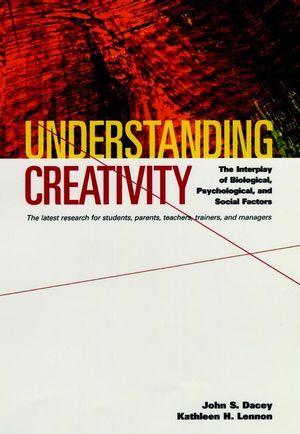Understanding Creativity: The Interplay of Biological, Psychological, and Social FactorsISBN: 978-0-7879-4032-4
Hardcover
310 pages
November 1998, Jossey-Bass
 This is a Print-on-Demand title. It will be printed specifically to fill your order. Please allow an additional 10-15 days delivery time. The book is not returnable.
|
||||||
"This book by Dacey and Lennon combines the wonder and awe of human
creativity with the complexity of its study. The authors advance
the 'biopsychosocial' perspective as a model of the creative
process.... This new perspective promises to further our
understanding of the 'intricacies of the creative mind.' In the
process of studying this book, readers may increase the probability
of enhancing their own creativity." (Richard E. Ripple, professor,
educational and developmental psychology, Cornell University)
"Many intriguing ideas. Solidly researched and up-to-date. A must read for anyone interested in the puzzle of creativity." (David F. Hayes, Peabody and Brown)
"Dacey and Lennon have created a new way of looking at creativity and creative problem solving. Taking a giant step beyond traditional psychological and psychosocial models, the authors have joined biological research with that from the fields of cognitive psychology and social psychology. This highly integrated approach provides a more comprehensive understanding of the multifaceted findings of creativity research. The authors consider the reciprocal effects of the many diverse elements of their model on the development of individual creativity. In addition to reviewing current research, they set the stage for further scholarship, where their theoretical hypotheses can be empirically explored. A thought-provoking and fascinating work." (Susan Besemer, professor, SUNY College at Fredonia)
"Many intriguing ideas. Solidly researched and up-to-date. A must read for anyone interested in the puzzle of creativity." (David F. Hayes, Peabody and Brown)
"Dacey and Lennon have created a new way of looking at creativity and creative problem solving. Taking a giant step beyond traditional psychological and psychosocial models, the authors have joined biological research with that from the fields of cognitive psychology and social psychology. This highly integrated approach provides a more comprehensive understanding of the multifaceted findings of creativity research. The authors consider the reciprocal effects of the many diverse elements of their model on the development of individual creativity. In addition to reviewing current research, they set the stage for further scholarship, where their theoretical hypotheses can be empirically explored. A thought-provoking and fascinating work." (Susan Besemer, professor, SUNY College at Fredonia)



